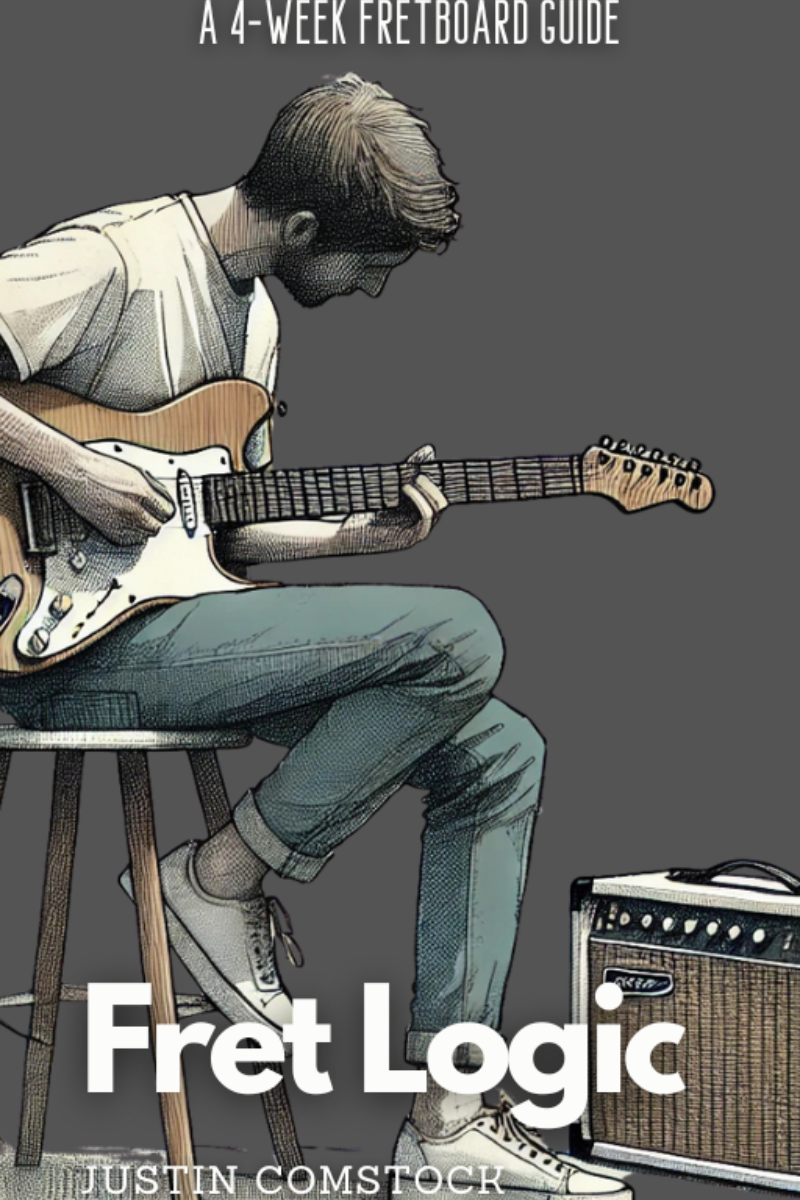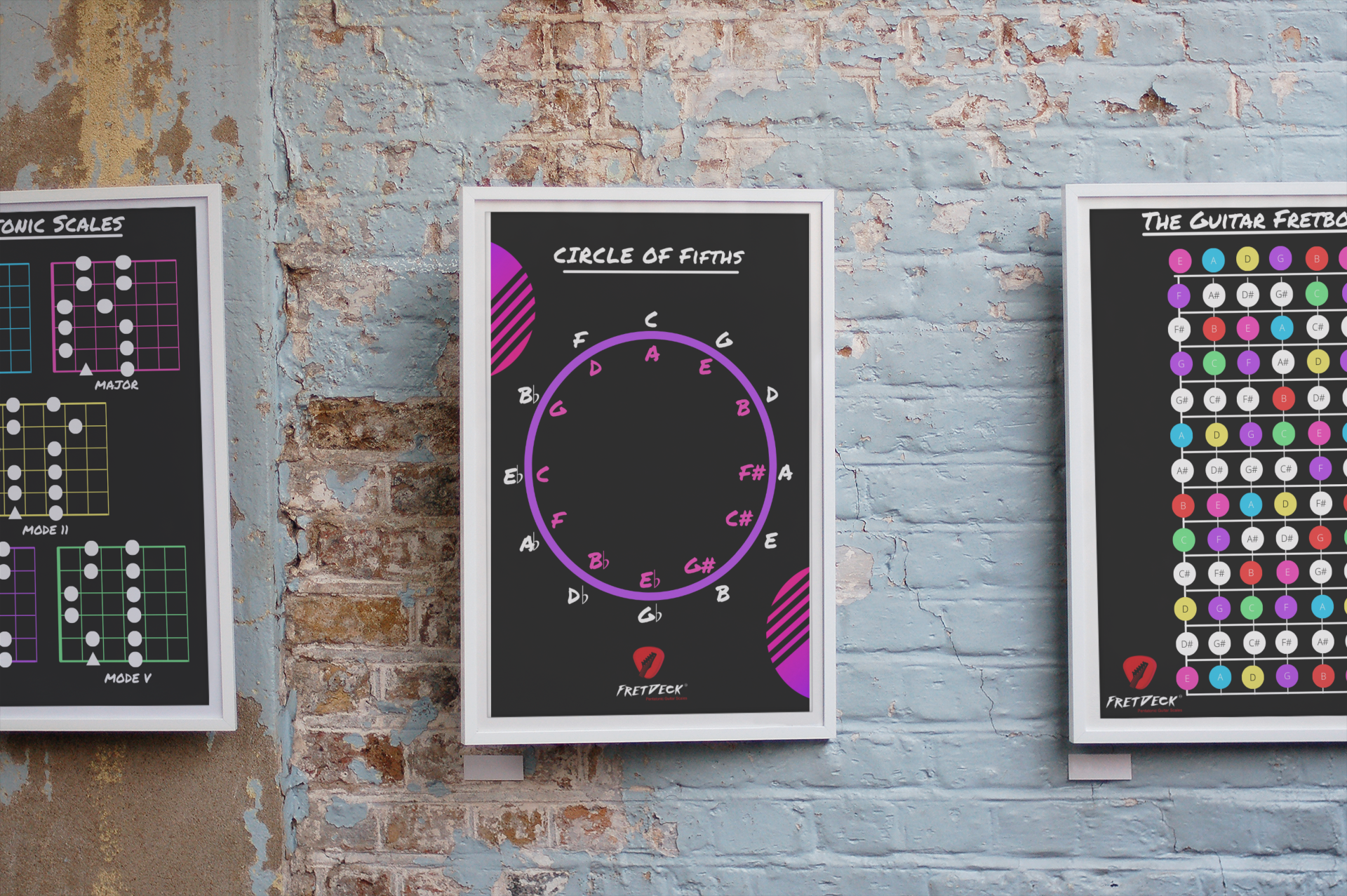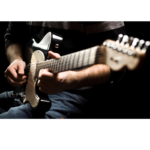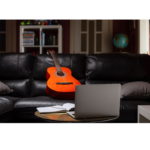Stop guessing. Start seeing the fretboard clearly.
The journey to mastering the notes on electric guitar can feel like wandering through fog with no compass.
But for my student Jack, that fog lifted the day he picked up a FretDeck™.
This isn’t another “just memorize the notes” lecture.
It’s a step-by-step walkthrough of how to master the fretboard using tools that work, scales that matter, and a real story to prove it.
Let’s decode the neck—once and for all.
🎯 Why Learning Notes on Electric Guitar Changes Everything
Every great player—from Hendrix to H.E.R.—has one thing in common:
They don’t guess.
They see the neck.
They know their notes.
When you master the notes on electric guitar, you can:
- Build chords on the fly
- Improvise with purpose
- Solo without running out of ideas
- Play in any key, anywhere on the fretboard
💡 This isn’t about memorizing—it’s about visualizing.
And that’s exactly what Jack learned to do.

❌ Stop Guessing. Start Shredding.
If you’re still fumbling through scale patterns and box shapes… it’s costing you progress.
FretDeck™ is the no-fluff system that shows you exactly how to master the fretboard—fast. Early access.
⚡️ This isn’t for dabblers. It’s for players who want results.
👉 Click here to join the pre-launch now
Early access. Limited rewards. Don’t wait.
📚 Jack’s Journey: From Frustrated to Fretboard Fluent
When Jack came to me, he was stuck.
Stuck in box patterns.
Stuck forgetting where C was.
Stuck noodling the same licks with zero confidence.
Then we brought in FretDeck™—and everything changed.
🧠 Step One: Understanding the Notes on Electric Guitar
Here’s a quick rundown of the 12 notes per string, up to the 12th fret. This is the foundation:
E String (6th & 1st):
E, F, F♯, G, G♯, A, A♯, B, C, C♯, D, D♯
A String:
A, A♯, B, C, C♯, D, D♯, E, F, F♯, G, G♯
D String:
D, D♯, E, F, F♯, G, G♯, A, A♯, B, C, C♯
G String:
G, G♯, A, A♯, B, C, C♯, D, D♯, E, F, F♯
B String:
B, C, C♯, D, D♯, E, F, F♯, G, G♯, A, A♯
👉 Every fret is one semitone higher. Once you get that, the fretboard becomes a map—not a mystery.
🔥 The Secret Weapon: FretDeck™
FretDeck™ isn’t a gimmick—it’s a physical deck of guitar learning cards built for visual learners.
Each card shows:
- One fretboard pattern
- Root note locations
- Pentatonic shapes and modes
- Interval breakdowns
- Circle of 4ths application
🎸 It’s the fastest way I’ve seen a student go from “lost” to “locked in.”
👉 Back FretDeck on Kickstarter Now »
🎵 The C Major Pentatonic Scale: Notes on Electric Guitar
The C major pentatonic scale includes:
C – D – E – G – A
Position 1:
e|---------------------------0--3--|
B|---------------------1--3--------|
G|-----------------0--2------------|
D|-----------0--2------------------|
A|-----0--3------------------------|
E|--3------------------------------|
Position 2:
e|---------------------------3--5--|
B|---------------------3--5--------|
G|-----------------2--5------------|
D|-----------2--5------------------|
A|-----3--5------------------------|
E|--3--5---------------------------|
🎶 The A Minor Pentatonic Scale (Same Notes, Different Sound)
The A minor pentatonic is the relative minor of C major—same notes, new flavor.
A – C – D – E – G
Position 1:
e|---------------------------5--8--|
B|---------------------5--8--------|
G|-----------------5--7------------|
D|-----------5--7------------------|
A|-----5--7------------------------|
E|--5--8---------------------------|
Position 2:
e|---------------------------8--10--|
B|----------------------8--10--------|
G|-----------------7--9-------------|
D|-----------7--10------------------|
A|-----7--10------------------------|
E|--8--10---------------------------|
Jack didn’t just play these patterns. He owned them.
How? He used FretDeck™ to see the shapes, name the notes, and connect them to chords.
🛠 Jack’s Practice Routine (Powered by FretDeck™)
- Daily Note Drill:
Jack reviewed each string’s notes with FretDeck. He walked the neck out loud—open to 12th. - Scale Exploration:
He pulled a pentatonic card and played that scale in every key—out loud, eyes up. - Chord-Scale Connection:
He’d pair a chord card with a scale card. Example: C major chord → C major pentatonic scale. - Improv with Purpose:
He soloed using only notes from the card—forcing his brain to “see” before playing.
💬 “It’s like I finally knew where I was going, instead of guessing.”
⚠️ Jack’s Setbacks—and How He Beat Them
❌ Struggling to connect scale positions
✅ We used root notes to build bridges between positions
✅ FretDeck’s interval markers made it visual
❌ Falling into familiar patterns
✅ We randomized card pulls—forcing new combinations
✅ This killed bad habits and unlocked creativity
🎯 Tips for Using FretDeck to Learn Notes on Electric Guitar
- Consistency over cramming – 10 minutes a day beats 1 hour on Sunday
- Say it, don’t spray it – Name every note out loud
- Track progress – Mark cards you’ve mastered
- Use the Discord – Get feedback and share wins
👉 Join Guitar Freaks Hangout on Discord + Get Fret Logic FREE »

Join Guitar Freaks Hangout on Discord! 🎸
Get Fret Logic FREE!
Join the Guitar Freaks Hangout Discord and get exclusive access to my entire e-book, Fret Logic! Master the fretboard and elevate your solos with this comprehensive guide.
👉 Don’t miss out—join now and download your free copy!
📈 Free Resource: 27 Guitar Charts to Help You Learn the Notes
Before FretDeck, I created 27 free guitar charts to help players master chords and fretboard notes.
🎁 Download them here: Free Guitar Charts
💡 Final Thoughts: Make the Neck Your Friend
If Jack can do it, you can too.
🎸 Learning the notes on electric guitar is more than an academic exercise. It’s the key to freedom.
Freedom to solo. Freedom to write. Freedom to jam with confidence.
And it starts with structure, support, and smart tools.
✅ Get your FretDeck™
✅ Join the Guitar Freaks Hangout Discord
✅ Visualize the neck
✅ Play with purpose
🎯 Don’t memorize blindly. Train intentionally.
🎁 Back FretDeck on Kickstarter Now »
👉 Want More?
Read next:
🔗 Guitar Fretboard Notes: 6 Strategies That Actually Work

Download FREE Guitar Charts!
We have 27 FREE guitar charts to help you learn the guitar fretboard. Learn How to play chords and scales with these free resources.
Free Guitar Resources










